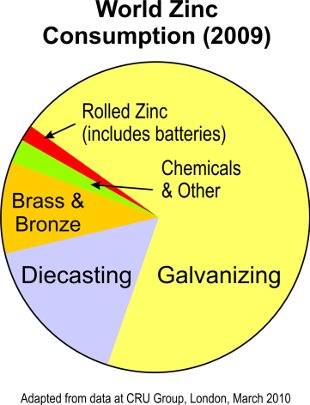The base metal zinc (Zn) is like an actor that switches character, depending on the role.
In animals, zinc performs thousands of vital functions ranging from DNA metabolism to brain synapse regulation. In plants, it helps to produce growth hormones and regulate starch formation, among countless other processes. Zinc is also versatile enough to interact with all the major and most minor industrial metals, as well as with gold and silver.
One of zinc's most important properties is its ability to combine easily with oxygen. Early scientists discovered that, if a piece of zinc is electrically connected to iron or steel, an electrochemical reaction causes oxygen to corrode the zinc instead of the iron or steel. At the same time, that reaction triggers a secondary reaction, which forms a protective coating over the zinc to reduce its corrosion rate. These phenomena underlie the modern-day process of galvanization: the layering of zinc over other metals to inhibit rusting or corrosion.
Zinc is the world's fourth most common metal and is mined in nearly fifty countries. Global zinc output is extracted mainly from sphalerite (ZnS), a zinc ore that typically occurs in association with the sulphide ores of other base metals such as iron, copper and lead.
Main Uses. The top two markets for zinc are galvanized steel and diecast zinc alloys. Stand in any city park, and you'll see hundreds of objects containing one or both metal products: swingsets, chain link fences, light posts, metal roofs, steel doors, door handles, window frames, automobiles, bridges and so much more.
The music world relies heavily on zinc. Your local concert band features brass instruments made of zinc alloyed with copper. Nickel silver—a combination of zinc, copper and nickel—is the main metal used in guitar frets, student flutes, and the keys of woodwind instruments such as oboes and clarinets.
Zinc compounds appear in many household products: zinc oxide in paints and sunscreens, zinc pyrithione in medicated shampoos, and zinc acetate in throat lozenges, to name just a few.

In animals, zinc performs thousands of vital functions ranging from DNA metabolism to brain synapse regulation. In plants, it helps to produce growth hormones and regulate starch formation, among countless other processes. Zinc is also versatile enough to interact with all the major and most minor industrial metals, as well as with gold and silver.
One of zinc's most important properties is its ability to combine easily with oxygen. Early scientists discovered that, if a piece of zinc is electrically connected to iron or steel, an electrochemical reaction causes oxygen to corrode the zinc instead of the iron or steel. At the same time, that reaction triggers a secondary reaction, which forms a protective coating over the zinc to reduce its corrosion rate. These phenomena underlie the modern-day process of galvanization: the layering of zinc over other metals to inhibit rusting or corrosion.
Zinc is the world's fourth most common metal and is mined in nearly fifty countries. Global zinc output is extracted mainly from sphalerite (ZnS), a zinc ore that typically occurs in association with the sulphide ores of other base metals such as iron, copper and lead.
Main Uses. The top two markets for zinc are galvanized steel and diecast zinc alloys. Stand in any city park, and you'll see hundreds of objects containing one or both metal products: swingsets, chain link fences, light posts, metal roofs, steel doors, door handles, window frames, automobiles, bridges and so much more.
The music world relies heavily on zinc. Your local concert band features brass instruments made of zinc alloyed with copper. Nickel silver—a combination of zinc, copper and nickel—is the main metal used in guitar frets, student flutes, and the keys of woodwind instruments such as oboes and clarinets.
Zinc compounds appear in many household products: zinc oxide in paints and sunscreens, zinc pyrithione in medicated shampoos, and zinc acetate in throat lozenges, to name just a few.

Outlook. Market trends for zinc, like those for most other base metals, tend to parallel fluctuations in the global economy. Some research groups predict that rising automobile sales in China and India may boost the demand for zinc throughout the early 2010s.
The following links give further information on zinc uses, production, technological advances and market data.
Commodity Summary for 2010 (Zinc) by United States Geological Survey.
Minerals Information: Zinc (2010) by United States Geological Survey.
Canadian Minerals Yearbook, 2008: Zinc by Natural Resources Canada.
International Zinc Association. Offers comprehensive information on the uses, history, chemistry, metallurgy, markets and global production of zinc.

